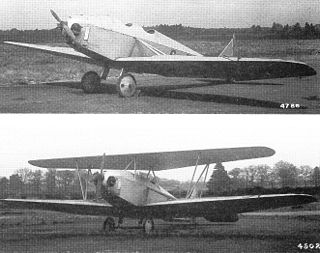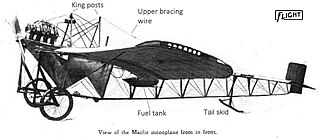
The Antoinette IV was an early French monoplane.
The Blackburn Second Monoplane was strongly influenced by the French Antoinette and was much more successful than Robert Blackburn's first aircraft. The lone aircraft was built in Leeds, UK in 1910.

The Parnall Pixie was a low powered British single-seat monoplane light aircraft originally designed to compete in the Lympne, UK trials for motor-gliders in 1923, where it was flown successfully by Norman Macmillan. It had two sets of wings, one for cross-country flights and the other for speed; it later appeared as a biplane which could be converted into a monoplane.

The Tipsy B was a small sports two-seat monoplane designed by Ernest Oscar Tips, and built in both Belgium and the UK. A total of 42 was built, and a few are still flying.
The Blackburn Type E was a development of the earlier Blackburn Mercury single-engined monoplanes, but was innovative in its use of steel tubing to construct the fuselage. It was built during 1912 to compete in the Military Aeroplane Trials. A single-seat version flew, but the military two-seater did not.

The Macfie monoplane was a British shoulder wing, tractor monoplane. The aircraft was powered by a 35 hp (26 kW) J.A.P. V8 engine fixed at the front of an open-frame 'fuselage', at the rear end of which a tailplane and vertical rudder were mounted.

The Skyeton K-10 Swift is a two-seat, single-engine light sports or ultralight aircraft designed in Ukraine.

The IAR-22 was a single engine basic trainer built in Romania in about 1934. It was a low-wing monoplane with two seats in tandem and a fixed conventional undercarriage.

The twin-engined CANT Z.1011 was one of two bombers of about the same size and powered by the same engines, designed by Filippo Zappata in the mid-1930s. The other was the three-engined CANT Z.1007, which in the end was the type preferred by the Regia Aeronautica.
The Eurofly FB5 Star Light is a single engine kit built Italian ultralight, seating two side by side. It first flew in the late 2000s.
The Bernard SIMB V.1 was a French single seat racing monoplane designed to compete for the 1924 Beaumont Cup. It crashed on its first flight and was not rebuilt.
The Wendt W-2 Swift was a two-seat, single-engine, braced high-wing monoplane built in the United States just before World War II. Only one was built.
The Star Monoplane was an early British aircraft built by the Star Engineering Company of Wolverhampton. A tractor configuration monoplane resembling the French Antoinette aircraft, its most remarkable feature was the arrangement of the rear control surfaces. It was exhibited at the Aero Exhibition at Olympia in London, in 1910.

The 1910 Deperdussin monoplane, is a general term for a variety of Deperdussin aircraft models built between 1910 and 1911. Initially released in August 1910, it was the first aircraft to be built in significant quantities by Aéroplanes Deperdussin. Many variations of the aircraft were produced, differing in size, engine type and horsepower and tail configuration. These were loosely labelled as the "Deperdussin monoplane", but were sometimes more specifically classified either by function or by seating-type. A number of Deperdussin monoplanes were flown successfully in air races and gained several speed and endurance records during 1911–1912. Several have survived, including an airworthy example in the Shuttleworth Collection in England.
The Gribovsky G-10 was a single seat sports aircraft designed and built in the USSR in the early 1930s.
The Gribovsky G-21 was a single engine cabin monoplane designed and built in the USSR in the mid-1930s. Intended for touring and civil utility rôles, only one was completed.

The Gribovsky G-22 was a low powered, single seat sports cantilever monoplane, designed and built in the USSR in the mid-1930s. It set at least one class record and flew from 1936 to at least 1940, though only one was completed.
The Gribovsky G-26 was a single seat sports aircraft designed for high performance in the USSR in the later 1930s. Only one was built.

The Potez 31 was a prototype French two-seat night fighter, flown in about 1928, intended to fill the Cn.2 specification for the Armee de l'Air. Only one was built.
The Potez 38 was a French single engine, eight or nine seat passenger aircraft flown in 1930. Only one was built.











